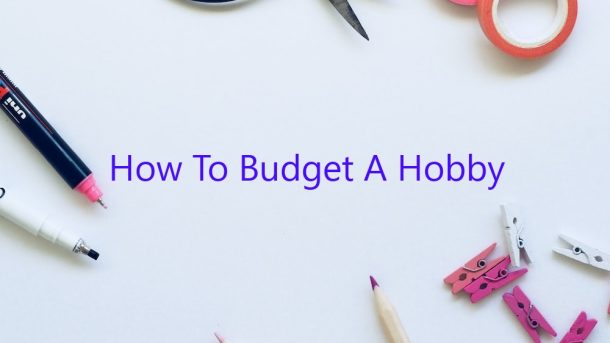When it comes to budgeting, everyone has their own way of doing things. There is no right or wrong way to budget, as each person’s individual needs and wants vary. However, if you’re looking to budget your hobby, there are a few key things to keep in mind.
The first step in budgeting your hobby is to calculate how much money you can realistically afford to spend on it each month. This may take a little bit of time and effort, but it’s worth it in the end. Once you have a good idea of how much money you can spare, you can start to create a budget that works for you.
When creating your budget, it’s important to be realistic. Don’t overspend just because you think you can afford it. Instead, be mindful of what you’re spending and make sure that your hobby doesn’t impact your other financial goals.
In addition to setting a budget, it’s also important to track your spending. This will help you stay on track and make sure that you’re not overspending on your hobby.
If you’re looking to budget your hobby, these tips should help get you started. Just remember to be patient and stay flexible. Creating a budget is a process, and it may take some time to get it just right.
Contents
How do you create a budget for hobbies?
Creating a budget for your hobbies can be a great way to ensure that you’re able to continue enjoying them without putting too much strain on your finances. Here are a few tips on how to get started.
Start by evaluating your spending on hobbies over the past few months. This will give you a good idea of how much you’re currently spending on your hobbies. Once you have this number, you can start to figure out how much you can afford to spend going forward.
One way to do this is to break your hobby spending down into categories. For example, you might have categories for equipment, travel, and classes. This will help you to see where you might be able to save money.
If your hobby involves purchasing equipment, try to find used equipment instead of buying new. This can help you to save a lot of money.
If you like to travel for your hobbies, try to find cheaper ways to do it. Look for deals on flights and hotels, and consider travelling during off-peak times.
If you take classes to pursue your hobby, see if you can find a cheaper option. There are often classes available at community centres and local libraries.
By creating a budget for your hobbies, you can make sure that you’re able to continue enjoying them without putting too much strain on your finances.
What is the 70 20 10 rule with your budget?
The 70 20 10 rule is a budgeting principle that suggests that 70% of your budget should be devoted to essentials, 20% to savings and 10% to discretionary spending. This rule can help you create a budget that is realistic and achievable.
The 70% portion of your budget should be devoted to covering your essential expenses, such as housing, food, transportation and utilities. It’s important to make sure that you are realistic when creating this section of your budget, and that you do not overestimate your expenses.
The 20% portion of your budget should be saved for future expenses, such as retirement or a rainy day fund. This savings can help you cover unexpected expenses or help you achieve your financial goals.
The 10% portion of your budget should be used for discretionary spending, such as entertainment, dining out and vacations. This is money that you can use to enjoy life and have some fun.
Using the 70 20 10 rule can help you create a budget that is realistic and achievable. By dividing your budget into these three categories, you can make sure that you are covering all of your bases.
What are the first 5 things that you should list in a budget?
When you’re creating or reviewing your budget, the first five things you should list are: 1. Your income 2. Fixed expenses 3. Variable expenses 4. Debt payments 5. Savings goals.
1. Your income – This is your starting point. List your total income for the month, including your salary, any side hustles or other income, and any money you expect to receive.
2. Fixed expenses – These are expenses that you have every month, no matter what. This might include your rent or mortgage, car payments, insurance premiums, and other recurring bills.
3. Variable expenses – These are expenses that can change from month to month. This might include groceries, entertainment, and travel costs.
4. Debt payments – List your total debt payments for the month, including credit card bills, student loans, and other debts.
5. Savings goals – List your savings goals for the month, including your emergency fund, retirement savings, and other goals.
How much time should you spend on a hobby?
How much time should you spend on a hobby? This is a question that a lot of people have, and there is no definitive answer. It really depends on what you are looking for in a hobby, and how much time you have to dedicate to it.
If you are looking for a hobby that is going to take up a lot of your time, you may want to consider something like golf or quilting. These hobbies can require a lot of practice and time to get good at them. However, if you are looking for something that you can do in your spare time, you may want to consider something like painting or stamp collecting. These hobbies can be done in short bursts, and you can still get a lot out of them.
No matter what you choose, it is important to make sure that you are enjoying the hobby. If you are not enjoying it, you are going to be less likely to stick with it. So, find a hobby that you are interested in, and then give it a try. See how much time you have to dedicate to it, and go from there.
How much money should I spend on fun?
How much money should I spend on fun? This is a question that a lot of people ask themselves, and the answer can vary depending on your individual circumstances. However, there are some general guidelines that you can follow to help you make the most of your money while still having fun.
One rule of thumb is to only spend money on activities that you enjoy. If you’re not having fun, then you’re wasting your money. Furthermore, try to find affordable activities that you can do on a regular basis. This will help you to stay within your budget while still having some fun.
Another thing to keep in mind is that you don’t need to spend a lot of money to have a good time. There are plenty of free activities that you can enjoy, such as going for a walk, visiting a park, or watching a movie outdoors. Additionally, there are many affordable activities that you can do, such as going to a restaurant or a bar, seeing a show, or taking a trip.
Ultimately, how much money you should spend on fun depends on your individual circumstances. However, by following the guidelines mentioned above, you can make the most of your money while still having a good time.
How do you organize your hobbies?
Organizing your hobbies can be a great way to keep your life balanced and make the most of your free time. Here are some tips on how to get started.
1. Figure out what you enjoy doing. This may seem like a no-brainer, but it’s important to take the time to think about the activities that make you happy. Once you have a list of things you love, you can start thinking about how to organize them.
2. Consider your interests. If you’re not sure where to start, think about the things you’re interested in. Do you love reading, crafting, or playing sports? Once you have an idea of your interests, you can start looking for ways to group them together.
3. Find a hobby organization system that works for you. There are lots of different ways to organize your hobbies, so find one that fits your lifestyle and personality. Some people prefer to keep everything in one place, while others like to have a separate space for each hobby.
4. Make a schedule. Once you have your hobbies organized, it’s important to make a schedule for yourself. This will help you make the most of your free time and ensure that you’re not trying to fit too many activities into one day.
5. Stick to it! The most important thing when it comes to organizing your hobbies is to be consistent. If you find that you’re not sticking to your schedule, try adjusting it until it works for you.
What is a healthy monthly budget?
A healthy monthly budget means different things to different people. But in general, it means knowing how much money you have coming in and going out, and making sure you have enough money to cover your essential expenses.
Your budget should include:
Your income
Your essential expenses, like rent, utilities, and groceries
Any other expenses you may have, like entertainment, travel, or debt payments
Your budget should be tailored to your unique situation. So if you have a lot of debt, for example, you may need to allocate more of your budget to debt payments.
One of the best ways to create a healthy monthly budget is to track your spending for a few months. This will help you get a better idea of where your money is going. You can use online tools or apps, or you can simply track your spending in a notebook.
Once you have a good idea of your regular expenses, you can start to create a budget that works for you. Try to be realistic about how much money you can afford to spend each month on things like entertainment and groceries. And remember to always leave some room in your budget for unexpected expenses.
If you’re having trouble sticking to your budget, there are a few things you can do:
Track your spending more closely
Find cheaper alternatives for your regular expenses
Create a savings goal and make automatic contributions to your savings account
If you follow a healthy monthly budget, you’ll be able to better manage your finances and save for the future.




